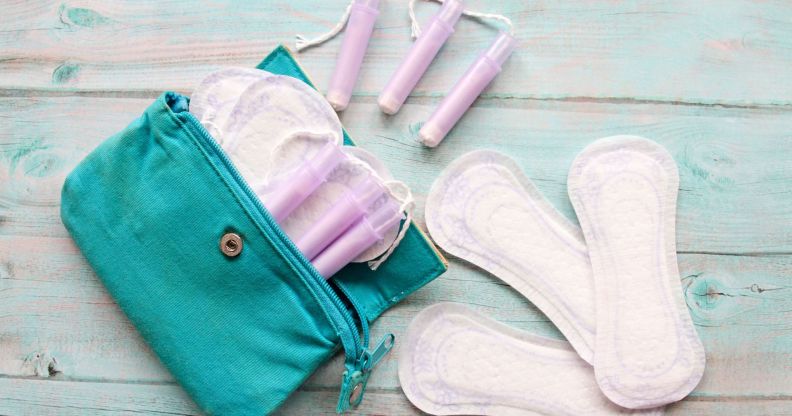Campaigners call out ‘deep-seated stigma’ as period products are tested with blood for first time ever

Campaigners have called out ‘deep-seated stigma and miseducation’ as tampons and pads are tested with blood for the first time ever. (Getty Images)
Campaigners have called out the need to tackle “deep-seated stigma and miseducation” around menstruation, as period products are tested using blood for the very first time.
It found that most products are far less absorbent than claims made by manufacturers.
A study published in the journal BMJ Sexual & Reproductive Health on 7 August 2023 is the first ever to compare absorption levels of menstrual products, including tampons, pads, cups and menstrual discs, using human blood.
Previous studies have traditionally used saltwater or water for testing, despite periods being more viscous, and containing blood cells and endometrial tissue, which affect absorption.
The study found that menstrual discs may be more absorbent of heavy flows than pads or tampons.
“The fact that period product absorbency has only just started to be tested with actual blood shows just how far we have to go when it comes to menstrual health, bodily education and period normalisation,” menstrual equity charity Bloody Good Period told PinkNews.
“Period blood in adverts has long been shrouded in secrecy and shame, through the use of ‘blue blood’ – and the fact that this is reflected right back to the product testing phase highlights the deep-seated stigma and miseducation that exists around periods.”
Instead of actual menstrual blood, which is hard to obtain for scientific testing, researchers used packed red blood cells – blood after the plasma and platelets are removed – with the study’s authors adding “blood products are a closer approximation than water or saline”.
The authors added: “No study exists comparing the capacity of currently available menstrual hygiene products using blood.”
The testing measured the capacity of 21 period products for comparison, which included several different products claiming different levels of absorbency, from several brands. The team claimed there was a mismatch between reported absorbency and actual absorbency of the products, with most brands claiming they had a higher absorbency level than research found.
Experts claim the findings could not only help doctors better assess whether heavy periods are a sign of underlying health problems – such as fibroids – but also help people who menstruate better choose suitable products for them.
Sex educator Erica Smith told PinkNews that if the Pictorial Blood Loss Assessment chart – a tool for assessing how much blood loss is happening in a period – is updated in light of studies that use real blood, it could “affect how people are reporting the amount of blood they lose during menstruation”.
“If we are accurately understanding how much blood our menstrual products capture, then health care providers will have a more accurate assessment if heavy bleeding is a concern,” Smith said.
Smith added: “I was surprised to hear [about the study] but in a way not surprised, because menstrual health and things related to the sexual health of AFAB people has been historically understudied and underprioritized.
“I think the study is great because it gives people a real practical sense of what period products will be most useful for their particular level of bleeding.”
Bloody Good Period told PinkNews: “Testing period products with actual blood will not only help to create better products in the future, but it will also help to normalise and promote accurate conversations around menstruation.
“When people are given good-quality products that are actually properly designed for the reality of menstruation – not saline – it gives us all the tools, education and information that we need in order to be better equipped to understand our bodies and menstruation.”
Bloody Good Period added there is still a long way to go on this issue, with tackling stigma and period poverty part of its key campaigns for the UK government.
The charity explained: “Menstrual stigma is still very much present in today’s society, and periods have become a penalty that we pay with our health, education and work.
“Currently, 1 in 5 people struggle to afford period products, 89 per cent of people are stressed or anxious about having their period at work – with 14 per cent of people avoiding or missing work during their period, and 13 per cent of young people have missed school or university or college because of their period.”
Trans and non-binary activists have also stressed that inclusivity is crucial for ending period poverty.
Kenny Ethan Jones, who made history as the first trans man to front a period campaign, previously told PinkNews that “equal access to healthcare” and adequate menstrual care needs to include the voices of women, trans men, and non-binary people.
“Even if all cis women were taken care of, there will still be period poverty because trans people are not taken care of,” Jones said.
“Period equity means all of us have to have access to products, education, feel seen and are taken care of health-wise.”
Bloody Good Period added: “Period poverty in the UK is becoming an increasingly bigger issue, year on year.
“Period products should be freely available – and they should be accompanied by informative, shame-free, inclusive education, normalisation and practical support.”
How did this story make you feel?

